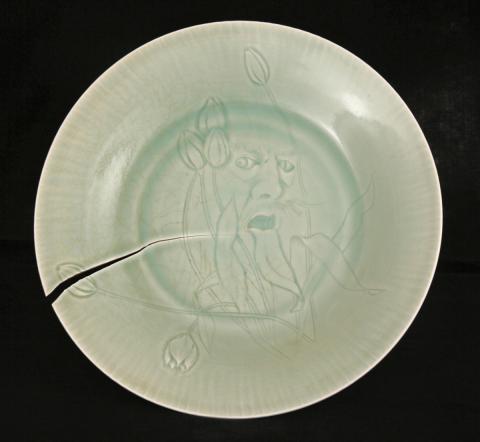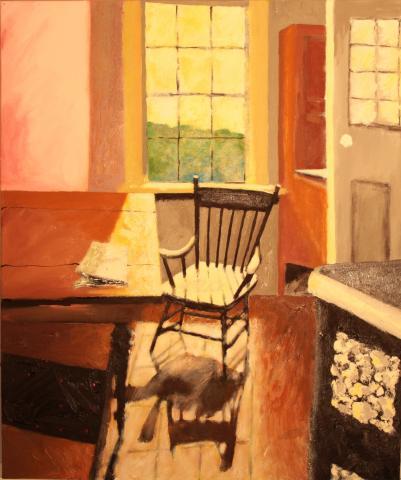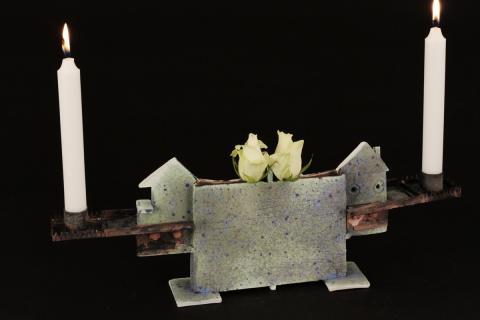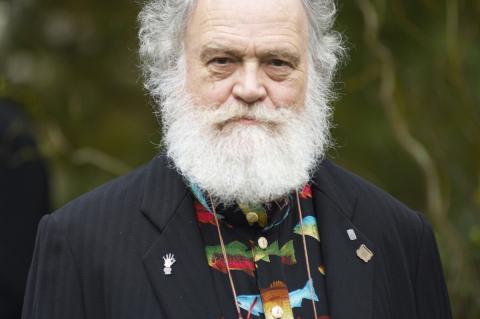BACHELOR OF FINE ART IN CERAMICS, 1969
ALUMNI DISCOVERY INITIATIVE, INTERVIEW BY POLLY ORR, 2016
Photo: Harlan House. Photo by Ned Pratt.

Six Pack tulip wall platter self-portrait with RGM celadon, 1999.
Polly Orr: I understand that you work primarily with ceramics in your present career. Was that your major in ACAD? And did you know when you started your degree that this would be your primary interest?
Harlan House: No, I went to ACAD to be a painter. After my third year, I switched to ceramics, and spent the next two [years] in that program. I continued to paint, and still do, but my main interest has been ceramics for over 45 years.
ORR: With the way glazes work, do you find your paint practice informs your ceramic work?
HOUSE: It is not so much the painting practice that informs as it is the drawing skills and the seeing skills...an old hangover from sculpture classes in the first three years at ACAD.

Kitchen still life (2017), oil on canvas, 91x76cm.
ORR: Currently at ACAD there is a strong encouragement for interdisciplinary practices, and from the sounds of it you dabbled in a few different mediums (sculpture, painting and ceramics) Have you found that there are benefits to this type of artistic approach?
HOUSE: Yes. Although the mediums are different, the job of the artist is still the same. The activities are different and usually compliment one another. The job of being able to see clearly, and fully in any discipline is a challenge, and being introduced to these media in art school is a far better solution than doing it on the fly in a professional setting. Having a set of tools to do the job is always a good idea, and it is not a bad thing to have good tools to work with, too. ACAD gave me those tools.
ORR: Throughout your years as an artist, you have obviously gained a level of mastery in what you do. What has been the biggest evolution you've experienced in your art career since being at ACAD?
HOUSE: First...back to the last question just for a moment. I would not use the word dabble, it suggests the wrong things. I was very serious about each area and medium, as were my classmates. I would also add that by experiencing various disciplines in school, the artist gets to appreciate how difficult each area is to work in. Sometimes a painter thinks potter is less of an artist, but will quickly realize differently if he or she tries it. You gather much greater respect for each other by knowing how hard each discipline is.

Rose house with decks and outdoor lighting, 2016.
ORR: That's a great point. It is very important for artists to take themselves and each of their crafts seriously in order to make the most out of their education. Thanks for the clarification!
HOUSE: Now...to your question about evolution. I don't think there has been a single path of evolution. I went to school, to a real "art school" where we were expected to become artists. There was no other path for me than to just do it. What evolved over the years is what you might expect. As with anything, it takes practice, and that is what I have done and am still doing.
ORR: Personally, that's one of my personal favourite parts of being an artist. The journey of discovery never ends! But despite the joys of being a lifelong learner, there can also be certain challenges that come with a commitment to an artistic life. Are there any specific challenges that you have faced within your art career and how did you overcome them?
HOUSE: I have, and still do face challenges. As a potter who makes mostly functional works of art, I find that most art organizations whether they be art schools or other institutions find anything at all that is accessible to be of lower art value. A local and fairly important art gallery in Kingston just had a show where they programmed young people entering the art world together with older artists who have made their mark. They did not include anyone in the so-called craft area, only painters and the odd sculptor. I find that this kind of thinking is normal in most art organizations, and for the life of me don't know why. I had to fight tooth and nail with the Canada Council many years ago so that craftspeople could be on the same footing as painters and sculptors and now filmmakers. It took time and seems to be working.

Duck-handled thrown bowl in Harlan House celadon, 2005.
ORR: Well I am sure there are many artists who appreciate your efforts. ACAD now has a specific craft program, and last year we implemented a graduate program within the craft school. But although there are different programs within the school (craft, fine art, and design) efforts are taken to create a sense of equilibrium and value amongst all practices. Hopefully these types of efforts continue, as like you said, once you try other types of art you gain a true appreciation for how much skill it takes.
In terms of additional efforts ACAD could make to involve themselves with the broader art community, is there anything you could envision ACAD doing to reach out to or interact with their alumni more?
HOUSE: I suppose there could be some use for more information. If more people understood the real, and actual value to our economy that the arts contribute that would be helpful. It is always a blow the side of the head to find out just how big the arts are in our life. Accountants love to count beans, so let’s give them something to count, and at the same time let’s tell our young artists how important they really are to people like accountants. It would be helpful to have information that could, for example, inform the CEO of a company too. They need to know that after work, the arts kick in big time, and that they are very, very important parts of our daily life.

Marine Wudi flower porcelain home, 2013.
ORR: Very well put! After looking at your CV, I see that you have had many different teaching engagements. What would you say is the main difference between the experience of learning art versus teaching art?
HOUSE: Almost all of my teaching has been in the form of workshops. I taught full time at the University of Calgary for one semester and learned all I needed to know about the teaching profession. I learned that to be a good teacher, I had to do it full time, which meant that the work that I was doing in ceramics would have to go on the back burner. I had to choose one profession or the other and chose to be full time working potter. I am glad that I did that, because otherwise I might have been bad at both jobs, and there is nothing worse than a bad teacher.
ORR: I have one last question for you. If you had any advice to give to an incoming first year, what would it be?
HOUSE: It would be exactly the same advice Illingsworth Kerr gave to us in 1964. He said that if you were joining the art world to be rich or famous, leave now. I stayed.
ORR: It's been a pleasure talking to you. Thank you for taking your time to share your insights! Enjoy the rest of your day.
